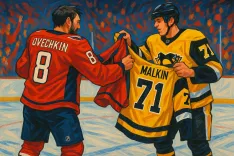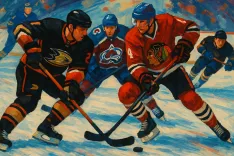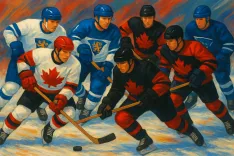Evaluating Prospect Performances Post-World Juniors

The performance of prospects at the World Juniors often prompts reflection on their potential and how these performances align with pre-existing evaluations. While a standout tournament can generate excitement, it is important to distinguish between genuine development and recency bias. Tournament results do not guarantee NHL success; therefore, careful examination of specific aspects of a player's game is vital for drawing informed conclusions. Following the conclusion of the tournament, several prospects have raised their profiles, while others have seen their stock diminish, and some have remained consistent in their assessments.
Honorable mentions for exceptional performances go to Danny Nelson (USA), Adam Jiricek (CZE), Felix Unger Sorum (SWE), Otto Stenberg (SWE), Juraj Pekarcik (SVK), Jesse Kiiskinen (FIN), Eriks Mateiko (LAT), and Linards Feldbergs (LAT). Notably, Cole Hutson (USA) made history with 11 points in the tournament, becoming the first defenseman to lead the tournament in scoring.
Ryan Leonard (USA) exemplified outstanding leadership and performance as Team USA's captain. His ability to score, draw penalties, and drive to the net were instrumental in the team's success, earning him the tournament MVP award. Leonard finished with ten points, including five goals, and his relentless play both with and without the puck impressed scouts, particularly the Washington Capitals.
Gabe Perreault (USA) reaffirmed the wisdom of not turning pro yet, elevating his game beyond last year's performance. His playmaking ability created opportunities from nearly impossible situations, leading him to finish fifth in scoring with ten points and a +10 rating. Though plus/minus is not the sole measure of performance, it reflects his effectiveness during the tournament, making Perreault a coveted prospect for the New York Rangers as they consider signing him after his return to Boston College.
From Sweden, Axel Sandin Pellikka stood out despite his team not medaling. As captain, he contributed significantly to Sweden's offensive potential, leading in scoring among defensemen with four goals. His playmaking skills were critical during power plays, showcasing a high level of hockey intelligence. The Detroit Red Wings are likely eager to integrate him into their North American plans as soon as possible.
Matthew Schaefer (CAN) faced challenges during the tournament, including a collarbone injury that required surgery. Nevertheless, his capability to dominate games was clear before his injury. His vision, skating, and decision-making suggest promising potential for an NHL career, and he has already garnered attention from scouts who favor his recent performances.
Victor Eklund (SWE), regarded as a leading European prospect for the upcoming 2025 NHL Draft, demonstrated exceptional skills throughout the tournament. Even as one of the younger players, his contributions were vital to Sweden's efforts. Eklund's relentless forechecking and passing ability greatly enhanced his team's performance, finishing with six points including two goals.
Dalibor Dvorsky (SVK), a prospect for the St. Louis Blues, showed great potential during the tournament. His ability to create scoring opportunities consistently was demonstrated through nine points, five of which were goals. With this performance, he solidified his status and is expected to transition to the AHL's Springfield Thunderbirds, with potential for a call-up later this season.
In an intriguing case, James Hagens (USA) concluded the tournament with gold and nine points, yet the lack of clear progression raised questions. His steady play remains evident, but it has not been enough to secure his position as a top overall draft pick when compared to rising prospects like Schaefer. There remains ample time for Hagens to enhance his visibility as the season progresses.
Luka Radivojevic (SVK) maintained his positive assessment despite Slovakia's early exit from the tournament. He made astute decisions and was active offensively during games. Though he recorded two assists, his overall impact suggested that he is positioned well in prospect rankings.
Gavin McKenna (CAN) represented Canada as a young player with great promise despite the team's struggles. He exhibited flashes of brilliance, especially when paired with skilled teammates. McKenna's performance hinted at his potential, laying the groundwork for his future career as a prospect eligible for the 2026 draft.
Logan Hensler (USA) faced challenges during the tournament as a reliable player where inconsistencies in puck management and an increased penalty rate came to light. His struggles mirrored broader issues faced by the USA team, yet it reflected an area needing improvement in the future.
The performance of Hockey Canada, as a collective, warrants attention. Canada’s highest scorer only managed three points in five games, showcasing a lack of offensive output necessary for success at the highest level. The approach of integrating role players mirrored an NHL-style strategy that has not yielded success in recent tournaments. Moreover, the failure to optimally utilize available talent and create dynamic pairs stunted potential breakthroughs during pivotal moments. The consequences of this performance may not be fully evaluated until the impact on individual draft-eligible players becomes evident, despite the prevailing belief that their stocks should remain unaffected.
Additionally, while Sam Dickinson (CAN) struggled in several facets during the tournament, it poses questions regarding his development in the London Knights' system. He will need exposure to higher levels of competition to ensure he refines his decision-making and overall gameplay, ultimately benefiting his growth and trajectory in professional hockey.









